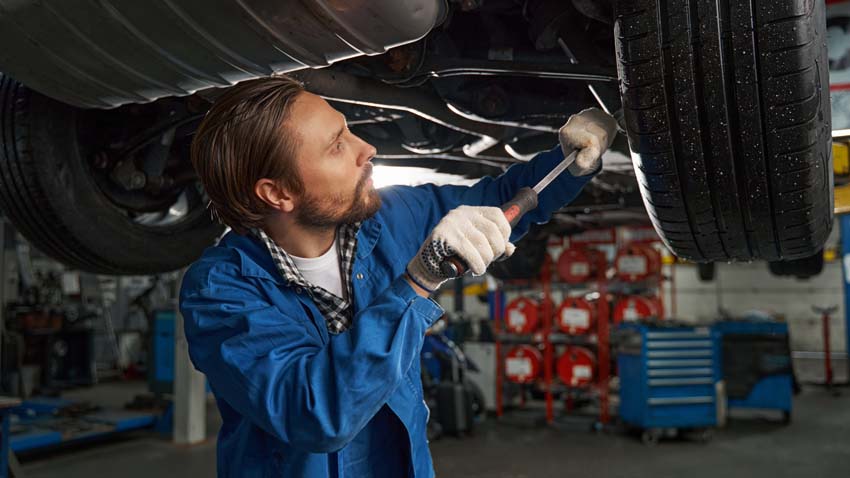
Figures released by the Driver and Vehicle Standards Agency (DVSA) reveal that 28.38% of initial MOT tests carried out in Great Britain during the period 2022/2023 resulted in test failure.
Checkup
They say prevention is better than cure. Well, that certainly applies to cars: spotting issues before they have a chance to become problems can save time, money and, potentially, a brush with the law.
The MOT test is a basic test of vehicle safety and roadworthiness. Anything that helps us stay safe has got to be good, right? However, just because something is good, doesn't mean it can't also be a huge pain and inconvenience. If your car fails its MOT test, a testing centre may, in some cases, refuse to release the vehicle for you to drive until the points of failure are rectified. If the testing centre does not also offer a repair service, there is a chance you could end up with a bill for transporting your car somewhere else for repairs.
Preventative medicine
Some potential MOT failure issues are things you can easily check: various lights, tyres, windscreen chips. Others you may suspect, even without the tools or knowledge to confirm. For example, if the brakes feel "spongy", squeak or don't seem to work as efficiently as they previously did, then it's reasonable to assume that some attention is required there.
By addressing the warning signs, doing the easy DIY jobs and getting your mechanic to check out the more specialist items, you can save the inconvenience of a test failure and the need for a retest after remedial work.
Another thing to note, even if your car does pass, is the list of advisories. These are issues that don't add up to a failure but which will need attention in the future. It's wise to get advisory issues sorted out well in advance of your next MOT.
The most common points of MOT test failure
Figures released by the Driver and Vehicle Standards Agency (DVSA) reveal that 28.38% of initial MOT tests carried out in Great Britain during the period 2022/2023 resulted in test failure. Below, we have set out the most common causes of failure. Many of the most frequent culprits are items that a simple weekly, or even monthly, visual check by the driver could have detected long before the MOT test became due.
Lamps, reflectors and electrical equipment
These were the most common issues, accounting for failure in 11.41% of tests overall. Changing a bulb takes a few minutes and a broken reflector is usually pretty obvious.
Suspension
The second most common failure point was suspension, which was the cause in 8.67% of tests. Unfortunately, suspension problems can be more difficult for the driver to detect or recognise. They can also cost a lot more to fix than a blown bulb or broken reflector.
Brakes
Faulty brakes were the third most common cause of MOT test failure, underlining the wisdom of getting brakes checked if they seem noisy, inefficient or if they just don't feel right. Brakes accounted for 6.66% of initial test failures.
Tyres
Hot on the heels of dodgy brakes we find dodgy tyres. The figure of 6.23% is markedly lower than it had been in previous years but it's still pretty high for an issue that can often be pretty obvious if one takes a few minutes to inspect the tyres every week or month.
Visibility
At number five in the failure charts, accounting for 4.89% of failures, we find issues affecting visibility. The obvious offender under this heading is the windscreen. If your windscreen is damaged in any way that seriously compromises the driver's clear view of the road, signs, traffic lights etc then you risk an MOT failure.
But there are other, less obvious, items that can also cause problems. The 'visibility' category also looks at windscreen washers and wipers, side mirrors, rearview mirrors (or cameras) and even bonnet catches. If a bonnet catch doesn't reliably keep the bonnet closed, or if there is a chance it may allow the bonnet to open and obstruct the driver's view then it will be considered a serious or dangerous fault.
Other defects
The DVSAs VT29 MOT test checklist for passenger vehicles divides test items into four main areas: 'Interior', 'Exterior', 'Under bonnet' and 'Under vehicle'. It lists 35 items to be checked under these area headings. Many of those items will require the tester to check a number of components and aspects. All in all, it's a pretty detailed and complicated examination.
Number plates
Of course, we scoured the lists for mention of number plates. While, thankfully, they don't feature in the rankings of top failure defects, number plates do appear on the MOT checklist under the 'External' heading.
We have often tried to discourage people from displaying number plates that don't comply with the official regulations. While it may be tempting to mis-space characters to make the representation of a word a little clearer, or to display your favourite football team's badge on your number plates, any deviation from the regulation specs risks an MOT failure (not to mention a fine).
The DVSA top defects chart
DVSA chart of initial MOT failures by category 2022-2023
| Defect category | Overall % of tests | Overall % of defects | Dangerous defects % of tests | Dangerous defects % of defects | Major defects % of tests | Major defects % of defects |
|---|---|---|---|---|---|---|
| Overall Initial Failure Rate | 28.38% | 7.71% | 20.67% | |||
| Lamps, reflectors and electrical equipment | 11.41% | 25.81% | 0.16% | 1.48% | 11.32% | 30.38% |
| Suspension | 8.67% | 18.98% | 0.49% | 5.26% | 8.38% | 21.55% |
| Brakes | 6.66% | 16.05% | 2.55% | 28.71% | 4.97% | 13.67% |
| Tyres | 6.23% | 12.44% | 4.75% | 60.10% | 1.74% | 3.48% |
| Visibility | 4.89% | 8.57% | 0.01% | 0.13% | 4.88% | 10.16% |
| Body, chassis, structure | 3.46% | 6.42% | 0.19% | 1.96% | 3.33% | 7.26% |
| Noise, emissions and leaks | 3.05% | 5.55% | 0.04% | 0.34% | 3.03% | 6.53% |
| Steering | 1.74% | 3.00% | 0.09% | 0.94% | 1.67% | 3.39% |
| Seat belts and supplementary restraint systems | 1.06% | 1.78% | 0.04% | 0.35% | 1.03% | 2.05% |
| Identification of the vehicle | 0.37% | 0.69% | 0.37% | 0.82% | ||
| Road Wheels | 0.35% | 0.69% | 0.07% | 0.72% | 0.28% | 0.68% |
| Seat belt installation check | 0.01% | 0.01% | 0.01% | 0.01% | ||
| Speedometer and speed limiter | 0.01% | 0.01% | 0.01% | 0.01% | ||
| Average defects per Initial Test Failure | 2.44 | 0.39 | 2.06 |
